These are small dishes we started the evening meal. Among the five items I served, only one is new which is in the blue bowl on the upper left. Upper center is squid stuffed with caramelized onion イカの飴色玉ねぎ詰 and tentacles, upper right is chicken liver simmered in red wine 鶏レバーの赤ワイン煮, lower left is sugar snaps soaked in dashi broth スナップ豌豆の塩びたし, and one in the small yellow container looking like a citrus fruit is uni or sea urchin "shuto" from Maruhide 丸秀のウニの酒盗.
This is a new item made from nagaimo and daikon. It is rather interesting and we like it.
As we mentioned before, when this squid dish is cold, I can slice it without separating the stuffing and the squid body. As you can see on the cut surface, quite few squid legs are stuffed. I drizzled our favorite spicy Spanish olive oil.
The below is another "teiban" 定番 in our household, red wine simmered chicken liver. This time I garnished with fresh thin slivers of ginger or "Hari-shouga" 針生姜.
Sugar snaps are good just blanched but this one was soaked in lightly seasoned Japanese broth. When you bite down, instead of water, you can get the subtle taste of the broth which makes an already good veggie nicer.
This is one of the five different kinds of sea urchin or uni "shuto" from Maruhide. When we got fresh uni last time, we also got these "shuto". Although frozen, they won't improve with age, so we have been hitting them regularly. This on is with hot chili and indeed the spiciness creeps up on you afterwards. This is almost as good as fresh uni.
For "Nagaimo no yukari-ae" 長芋のゆかり和えfrom E-recipe. I changed the amount of Yukari thinking the original recipe will make this dish rather salty.
Ingredients (for 2 servings, for the amount shown probably make 4 servings):
1 inch long daikon, peeled, sliced thinly and cut into thin julienne.
1 inch nagaimo, peeled, sliced thinly and cut into thin julienne.
1/2 tsp Yukari salt
1 and 1/2 tbs sweet vinegar (300ml rice vinegar, 120-150 gram sugar and 5-10 gram salt)
Directions:
Put both the daikon and nagaimo in boiling water. When it comes back to a boil, drain and let it cool in a colander.
Dress with Yukari salt and sweet vinegar.
This is a nice dish. My wife thought everything was nagaimo but this is a mixture of daikon and nagaimo which give an interesting texture difference. Yukari (dried red perilla) salt and sweet vinegar combination is very good giving nice refreshing taste. This is another way to use nagaimo and more interesting than sushi vinegar and aonori combination. In any case, we had cold sake with these starters.
Showing posts sorted by date for query nagaimo. Sort by relevance Show all posts
Showing posts sorted by date for query nagaimo. Sort by relevance Show all posts
Monday, August 13, 2018
Saturday, February 10, 2018
porridge with nagaimo 長芋お粥
My family never had a tradition of eating "Nanakusa-gayu" 七草がゆ or "seven herb porridge" which is usually eaten on January 7th. I am not sure of its history or reasons for it but in Japan, a package of 7 herbs for this dish appears in the market when the date nears. I made this porridge after we ran out of osechi and other dishes I made for the New Year. This is a rather interesting recipe which came from Buddhist monk Nishikawa 西川和尚. This porridge contains both grated and cubes of nagaimo 長芋. I made a slight modification and added baby water cress and topped with aomori powder and the meat of pickled plum. I served it with Mackerel simmered in miso sauce サバの味噌煮, red wine simmered chicken liver 鶏レーバーの赤ワイン煮 and simmered Japanese "kabocha" squash カボチャの煮物 for one weekend lunch.
This is a rather simple recipe. Instead of using a totally vegetarian broth (i.e. kelp broth), I used a combination of kelp and bonito flakes for the broth.
Ingredients (for two small servings):
3/4 cup of cooked rice (we microwaved frozen cooked rice to thaw it )
Nagaimo, 5 inch pieces, peeled, 1/3 grated and 2/3 cut into small cubes
1 cup of Japanese broth
Baby water cress, stems removed, an arbitrary amount
Dried aomori and umeboshi pickled plum meat finely chopped for garnish
Directions:
Add the cooked rice to a pan and add the broth, mix and simmer for 5 minutes.
Add the grated nagaimo, mix and simmer another 2-3 minutes.
Add the cubed nagaimo, add the water cress, season with the salt and cook 1-2 more minutes (do not over cook the nagaimo cubes).
Serve hot with the garnish of the Aonori, pickled plum and fresh water cress leaves.
The simmered Japanese "kabocha" pumpkin was prepared as before.
So were the mackerel and chicken liver.
The graded nagaimo added to the volume and, of course, added a unique texture to the porridge. The combination of grated texture with the nice crunch of the cubes of nagaimo was unique. This is very gentle soothing dish for your stomach.
This is a rather simple recipe. Instead of using a totally vegetarian broth (i.e. kelp broth), I used a combination of kelp and bonito flakes for the broth.
Ingredients (for two small servings):
3/4 cup of cooked rice (we microwaved frozen cooked rice to thaw it )
Nagaimo, 5 inch pieces, peeled, 1/3 grated and 2/3 cut into small cubes
1 cup of Japanese broth
Baby water cress, stems removed, an arbitrary amount
Dried aomori and umeboshi pickled plum meat finely chopped for garnish
Directions:
Add the cooked rice to a pan and add the broth, mix and simmer for 5 minutes.
Add the grated nagaimo, mix and simmer another 2-3 minutes.
Add the cubed nagaimo, add the water cress, season with the salt and cook 1-2 more minutes (do not over cook the nagaimo cubes).
Serve hot with the garnish of the Aonori, pickled plum and fresh water cress leaves.
The simmered Japanese "kabocha" pumpkin was prepared as before.
So were the mackerel and chicken liver.
The graded nagaimo added to the volume and, of course, added a unique texture to the porridge. The combination of grated texture with the nice crunch of the cubes of nagaimo was unique. This is very gentle soothing dish for your stomach.
Tuesday, March 28, 2017
Nagaimo and salmon sausage Isobe fry 長芋とサーモンソーセージの磯辺揚げ
This was inspired by the vegan cooking by a Buddhist monk in Kyoto. He briefly cooked the nagaimo 長芋 rounds in broth, soy sauce and mirin to season it before making a type of tempura called "Isobe-age" 磯辺揚げ with the batter containing dried "aonori" 青海苔. I also made salmon sausages we got from my mother for new year into a similar tempura. I served it as a drinking snack with green tea salt, wedges of lemon and skinned Campari tomato.
I cooked the nagaimo a bit too much but I just used the leftover nagaimo dish and converted to the current dish.
Ingredients (for two small servings):
Nagaimo, peeled and cut into half inch thick rounds (four)
Dashi broth, soy sauce, mirin and sake
Salmon sausages, sliced diagonally in half inch thick (four)
For the tempura batter
Cake flour and potato starch
Cold water
Dried "Aonori"
Directions:
1. Cook the nagaimo in seasoned broth (Japanese broth seasoned with soy sauce, mirin and sake) for few minutes and let it cool in the broth (see below, this one is cooked longer than called for in this dish).
2. Make the tempura batter by mixing the flours and "aonori" with cold water until desired consistency (I made this rather runny). Coat the nagaimo and sausages.
3. Heat vegetable oil (I used peanut oil) to 350F and deep fry for few minutes.
4. Drain and serve immediately.
Since this was converted from "simmered Nagaimo" dish, the nagaimo was cooked more than needed before it was deep fried. Still, it had nice crunchy texture. It has nice crust with aonori flavor. The salmon sausages also tasted much better than when we tasted as is. This was unusual but quite good tempura items.
I cooked the nagaimo a bit too much but I just used the leftover nagaimo dish and converted to the current dish.
Ingredients (for two small servings):
Nagaimo, peeled and cut into half inch thick rounds (four)
Dashi broth, soy sauce, mirin and sake
Salmon sausages, sliced diagonally in half inch thick (four)
For the tempura batter
Cake flour and potato starch
Cold water
Dried "Aonori"
Directions:
1. Cook the nagaimo in seasoned broth (Japanese broth seasoned with soy sauce, mirin and sake) for few minutes and let it cool in the broth (see below, this one is cooked longer than called for in this dish).
2. Make the tempura batter by mixing the flours and "aonori" with cold water until desired consistency (I made this rather runny). Coat the nagaimo and sausages.
3. Heat vegetable oil (I used peanut oil) to 350F and deep fry for few minutes.
4. Drain and serve immediately.
Since this was converted from "simmered Nagaimo" dish, the nagaimo was cooked more than needed before it was deep fried. Still, it had nice crunchy texture. It has nice crust with aonori flavor. The salmon sausages also tasted much better than when we tasted as is. This was unusual but quite good tempura items.
Wednesday, April 6, 2016
Hanami 2016 花見 2016
Again, Hanami 花見 season has come around. This year it was rather early and our backyard cherry trees were in full bloom on Easter weekend. The only problem for us was that we were out of town that weekend. We came back on Monday afternoon and found these spectacular cherry blossoms in our backyard (We were relieved that they were still in bloom). We have three different cherry trees; one that we planted and two that were already established on the property when we build the house. Usually the three trees reach peak bloom at different times but this year the two main trees bloomed at the same time making it more spectacular than usual.
The sky was blue and sunny but unfortunately it was chilly and very windy. We couldn't sit outside under the trees, so we had hanami looking from inside the house.
Since we just came back, we did not have anything special for Hanami so I made what I could from the cache in the freezer and also from food leftover from the trip. My wife bought these deviled eggs for a lunch on the road. They were not particularly flavorful and the worse for wear from the travel.
I made the first snack from these sorry-looking deviled eggs. I just defrosted some cod roe or tarako たらこ. I removed the skin and mixed in sake and a small amount of concentrated noodle sauce from the bottle.
I just put the mixture on the deviled eggs (after cleaning them up a bit) and garnished it with finely chopped perilla leaves and chives. This was quite an improvement over the original and was a perfect first bite with cold sake.
I also defrosted some natto 納豆 and mozuku もずくin sweet black vinegar. I made cucumber cups and placed the tarako mixture remaining from the deviled egg course in the cups (left). I put a small dab of wasabi and a light splash of soy sauce on the top. For the natto I used the sauce in the package and added wasabi instead of mustard and mixed well using my natto mixing contraption, then I added an egg yolk (Davidson's pasteurized egg). For texture I added finely diced nagaimo 長芋 and garnished with nori strips (center). I served mozuki in sweet black vinegar as is (right).
The wasabi on the tarako was "real wasabi".
Natto with egg yolk is a good combination and the nagaimo dice gave a nice texture contrast.
Mozuku seaweed is famous in Okinawa and perfect with sake.
Using whatever I had, I also made a small simmered dish or nimono 煮物 from nagaimo. grilled tofu 焼き豆腐 and shirataki 白滝.
This may not have been the ideal for hanami; if truth be told I was hankering for some sashimi but at least these drinking snacks were adequate and how bad can it be if you can sip sake gazing at a panorama of cherry blossoms?
Wednesday, March 23, 2016
Nagaimo and natto fry 長芋と納豆の落とし揚げ
This was a qualified success. However, we would much prefer natto tempra with perilla leaves 納豆と大葉の天ぷら.
Ingredients:
Natto, 1 pack, frozen, thawed, with a liquid seasoning pack and mustard
Nagaimo, 100g grated
Aomori, 1/4 tsp
Flour 2 tbs
Oil for frying.
Directions:
1. I placed the natto, nagaimo, and all the flavoring packs that came with the natto in a bowl.
2. I added dried aonori and flour.
3. Mixed them well.
4. Placed the batter on a spoon and dropped it into the hot oil. I fried it until the surface was crispy and brown.
I probably should have put more flour in this dish. It was a bit difficult to fry. I had to fold it while deep drying to make it come together. I may have over cooked it as well. The result was very light and crunchy without much substance. The natto was not sticky and had a rather assertive flavor. My assessment may not be fair to this recipe since I may not have made it properly. Nonetheless we probably much prefer natto tempra with perilla leaves.
Thursday, January 21, 2016
Another three appetizers お通し3種類
Here are other examples of drinking snacks--3 kinds. From left to right are blanched okra, burdock root salad and edamame.

I made the okra dish just before serving. The rest were prepared ahead of time.

1. Okura
Most of the time the okra I see at our regular grocery store is blemished and generally not good. This time, when I went to the grocery store, which is not our usual one, for Pasteurized eggs, I saw really fresh good looking okra and could not resist buying it. I first rolled the okra on the cutting board with Kosher salt to remove the fine hairs on the surface. I washed off the salt and blanched them in salted boiling water for 15 seconds and then cooled them in ice water. After they were cooled, I blotted the water from the surface and kept them in a sealed container in the refrigerator.
Just before serving, I sliced them into thin slices and dressed with soy sauce and dried bonito flakes.
2. Burdock root
I made this at the same time I made Kimpira. Instead of braising the burdock root, I boiled it in salted boiling water for a few minutes. I let it cool down and dressed in mayonnaise with a bit of soy sauce.
3. Edamame
This is just boiled frozen edamame. Since I had broth left over from the simmered atsuage and nagaimo dish, I just cut off the ends of the pods and soaked the edamame in the broth. I kept it for a few days in the refrigerator.
This threesomes was not bad (but not great either). Although I liked the okra, my wife did not like the residual sliminess (in general okra is not one of her favorites). The burdock root salad was good but I think the classic kimpira is better. The broth did not season the edamame as much as I thought it would. As a starter, however, this was more than adequate.

I made the okra dish just before serving. The rest were prepared ahead of time.

1. Okura
Most of the time the okra I see at our regular grocery store is blemished and generally not good. This time, when I went to the grocery store, which is not our usual one, for Pasteurized eggs, I saw really fresh good looking okra and could not resist buying it. I first rolled the okra on the cutting board with Kosher salt to remove the fine hairs on the surface. I washed off the salt and blanched them in salted boiling water for 15 seconds and then cooled them in ice water. After they were cooled, I blotted the water from the surface and kept them in a sealed container in the refrigerator.
Just before serving, I sliced them into thin slices and dressed with soy sauce and dried bonito flakes.
2. Burdock root
I made this at the same time I made Kimpira. Instead of braising the burdock root, I boiled it in salted boiling water for a few minutes. I let it cool down and dressed in mayonnaise with a bit of soy sauce.
3. Edamame
This is just boiled frozen edamame. Since I had broth left over from the simmered atsuage and nagaimo dish, I just cut off the ends of the pods and soaked the edamame in the broth. I kept it for a few days in the refrigerator.
This threesomes was not bad (but not great either). Although I liked the okra, my wife did not like the residual sliminess (in general okra is not one of her favorites). The burdock root salad was good but I think the classic kimpira is better. The broth did not season the edamame as much as I thought it would. As a starter, however, this was more than adequate.
Monday, November 30, 2015
Simmered Nagaimo and Fried tofu 厚揚げと長芋の煮付け
I bought atsu-age 厚揚げ at our Japanese grocery store one weekend thinking I would either add it to oden おでん or just grill it in the toaster oven but neither happened. I realized "the best tasted before date" was a few day AGO. So, instead of grilling, I switched to “emergency mode” and quickly made this dish which is like oden but has only a few items.
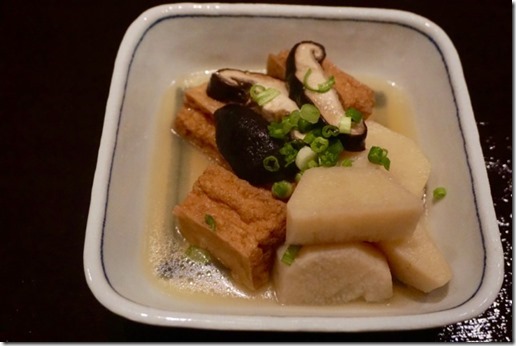
Again, I made this with what I had on hand. I had half a nagaimo 長芋 in the refrigerator left over from when I made yamakake 山かけ more than a week ago. I also had some nice thick shiitake mushrooms which I also bought at the Japanese grocery store sometime ago that needed to be used.
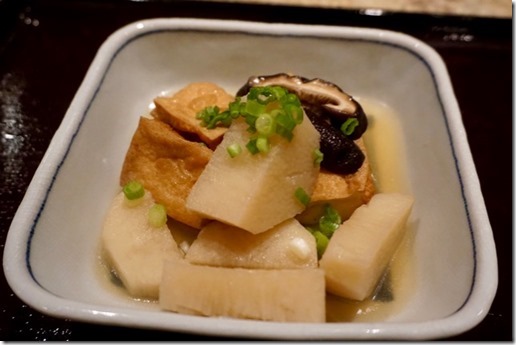
So this is the dish I came up with.
Broth: I made broth from dashi pack (dried bonito and kelp), added sake, mirin, light colored soy sauce. I supplemented the soy sauce with salt added in increments as I tasted. I used the salt because I did not want the nagaimo to become too dark as it would have if I used all soy sauce but I also wanted properly seasoned simmering broth. (I ended up using about 1/2 tsp of Kosher salt).
Atsu-age: I placed them in a colander and poured hot water over them (from the instant hot water dispenser which is connected to Culligan reverse-ososis filtering system) to remove excess oil. I then cut them in half.
Nagaimo: I peeled and cut into 1 inch-thick rounds and then halved them. I immediately soaked in water with a splash of rice vinegar.
Shiitake mushrooms: I removed the stems and cut into half inch slices (this was rather large and thick shiitake, possibly from Japan).
I placed the nama-age, nagaimo and shiitke in the broth and gently simmered it for 40-50 minutes. I served it in a bowl with a bit of the simmering broth and garnished it with chopped scallion.
This was a good combination. When cooked, the nagaimo looses it's sliminess and has a nice crunchy texture. This was perfect for cold sake.

Again, I made this with what I had on hand. I had half a nagaimo 長芋 in the refrigerator left over from when I made yamakake 山かけ more than a week ago. I also had some nice thick shiitake mushrooms which I also bought at the Japanese grocery store sometime ago that needed to be used.

So this is the dish I came up with.
Broth: I made broth from dashi pack (dried bonito and kelp), added sake, mirin, light colored soy sauce. I supplemented the soy sauce with salt added in increments as I tasted. I used the salt because I did not want the nagaimo to become too dark as it would have if I used all soy sauce but I also wanted properly seasoned simmering broth. (I ended up using about 1/2 tsp of Kosher salt).
Atsu-age: I placed them in a colander and poured hot water over them (from the instant hot water dispenser which is connected to Culligan reverse-ososis filtering system) to remove excess oil. I then cut them in half.
Nagaimo: I peeled and cut into 1 inch-thick rounds and then halved them. I immediately soaked in water with a splash of rice vinegar.
Shiitake mushrooms: I removed the stems and cut into half inch slices (this was rather large and thick shiitake, possibly from Japan).
I placed the nama-age, nagaimo and shiitke in the broth and gently simmered it for 40-50 minutes. I served it in a bowl with a bit of the simmering broth and garnished it with chopped scallion.
This was a good combination. When cooked, the nagaimo looses it's sliminess and has a nice crunchy texture. This was perfect for cold sake.
Sunday, November 15, 2015
Drinking snacks from frozen tuna block 冷凍キハダマグロのさくの酒のあて
One week we could not stop at our Izakaya substitute Tako Grill. So, on the following weekend, I tapped into our frozen emergency rations, i.e. frozen yellow fin tuna sashimi block to make several drinking snacks.
The first one was tuna and avocado cubes. This was similar to what I have made before; cubes of tuna sashimi and avocado dressed in soy sauce, sesame oil, with grated garlic. This time, however, I garnished it with crispy garlic chips since I had them already made.
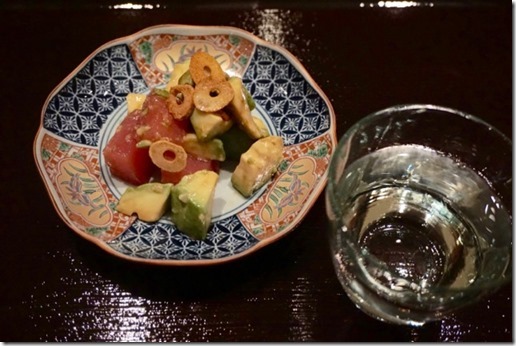
The second was pseudo negitoro ネギトロ擬き. Oh the magic of adding mayonnaise; it really tasted like real negitoro! I was thinking of serving this as a "shime" ending dish either as small sushi rolls or hand rolls but instead, I served it with nori sheets so that we would not get filled up. This worked very well. We made small rolls of negitoro wrapped in nori—excellent!
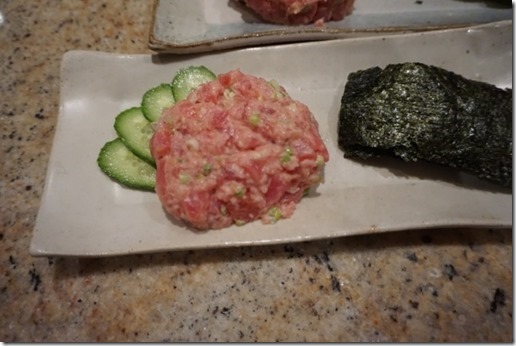
The third one was our usual yamakake 山かけ. I marinated the cubes of tuna for 1 hour or so in soy sauce and sake mix.
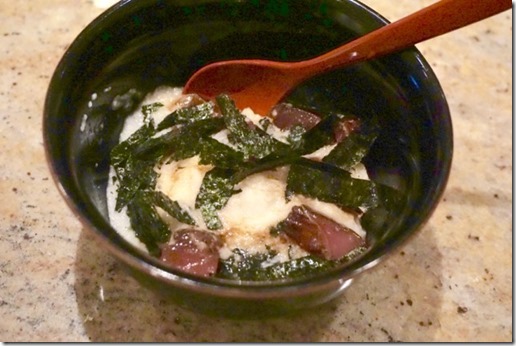
Because of the grated nagaimo yam, this dish is more filling than it looks. At this point we finished the entire block of yellow fin tuna. We wanted one more dish. So I served freshly made non-frozen fish cake or satsuma age さつま揚げ which I bought at our Japanese grocery store. I served it with burdock root salad dressed in sesame mayonnaise and Japanese shishitou green pepper 獅子唐芥子prepared in "Tsukuda-ni" 佃煮 style. I just broiled the fish cake in a toaster oven until thoroughly heated up and the surface showed some brown spots.
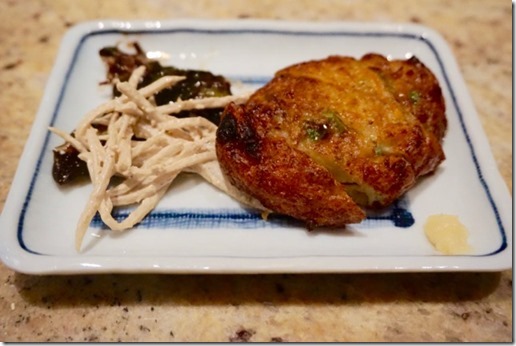
For this evening, we enjoyed Niigata 新潟 sake Kubota Senju 久保田千寿、吟醸. We were not a big fan of Kubota in the past. I remember the Kubota series, even the higher end ones, tended to be too dry and a bit yeasty but this one was quite fruity and crisp but not too dry and had no yeastiness. Several days, later we had a chance to taste 久保田万寿 Kubota Manju which is daiginjou. This one tasted drier than Senju. For the price, I consider Senju a much better buy.
At this point we were getting quite filled up but my wife wanted a small desert and served some grapes and a mini chocolate something. For a low quality frozen yellow fin tuna sashimi block, these dishes were quite enjoyable. We were especially impressed with the pseudo negitoro.
The first one was tuna and avocado cubes. This was similar to what I have made before; cubes of tuna sashimi and avocado dressed in soy sauce, sesame oil, with grated garlic. This time, however, I garnished it with crispy garlic chips since I had them already made.

The second was pseudo negitoro ネギトロ擬き. Oh the magic of adding mayonnaise; it really tasted like real negitoro! I was thinking of serving this as a "shime" ending dish either as small sushi rolls or hand rolls but instead, I served it with nori sheets so that we would not get filled up. This worked very well. We made small rolls of negitoro wrapped in nori—excellent!

The third one was our usual yamakake 山かけ. I marinated the cubes of tuna for 1 hour or so in soy sauce and sake mix.

Because of the grated nagaimo yam, this dish is more filling than it looks. At this point we finished the entire block of yellow fin tuna. We wanted one more dish. So I served freshly made non-frozen fish cake or satsuma age さつま揚げ which I bought at our Japanese grocery store. I served it with burdock root salad dressed in sesame mayonnaise and Japanese shishitou green pepper 獅子唐芥子prepared in "Tsukuda-ni" 佃煮 style. I just broiled the fish cake in a toaster oven until thoroughly heated up and the surface showed some brown spots.

For this evening, we enjoyed Niigata 新潟 sake Kubota Senju 久保田千寿、吟醸. We were not a big fan of Kubota in the past. I remember the Kubota series, even the higher end ones, tended to be too dry and a bit yeasty but this one was quite fruity and crisp but not too dry and had no yeastiness. Several days, later we had a chance to taste 久保田万寿 Kubota Manju which is daiginjou. This one tasted drier than Senju. For the price, I consider Senju a much better buy.
At this point we were getting quite filled up but my wife wanted a small desert and served some grapes and a mini chocolate something. For a low quality frozen yellow fin tuna sashimi block, these dishes were quite enjoyable. We were especially impressed with the pseudo negitoro.
Saturday, August 8, 2015
G Sake on the rocks G 酒 オンザロック
When we were at Izakaya Kurakura 蔵倉 in Kyoto recently, we had "Icebreaker" summer sake on the rocks which gave us the idea to taste G sake on the rocks. We posted G sake Joy and G sake Fifty in 2013. While they were good, we were not wild about these sakes (we liked the original G sake) and thought they were a bit too assertive/savory in taste with cloying sweetness (this tendency was more pronounced in "Fifty"). As a result several bottles of G sake have stayed in the refrigerator untouched. Since they were a rather assertive undiluted genshu with higher alcohol content (18% alcohol), we thought they may taste better on the rocks like Icebreaker sake.
We first tried G sake (2013 version) on the rocks.

The glass came from Kitaichi glass 北市グラス in Otaru 小樽. While we were in Japan, we noticed some of the Japanese tumblers were made of incredibly thin glass. We learned that since incandescent light bulbs are becoming a thing of the past in Japan, the same technology used to make light bulbs is being used to make very thin-walled glass tumblers. The ones we bought have little dimples on the sides making them easier to grasp. We tasted G sake "Joy" on the rocks in these tumblers accompanied with deep fried small sweet fish or "ayu".

A few days later, we tried G sake "Fifty" (2013 version) on the rocks. The major difference between "Joy" and "Fifty" is the degree to which the rice has been polished; 40 and 50% (of outer kernel removed), respectively.

This time we had octopus sashimi and raw ocutopus in wasabi yuzu dressing (in the square container, from a frozen package). I also served matchsticks of nagaimo in vinegar dressing garnished with dried "aonori".

We liked G sake "Joy" on the rocks. The cloying sweetness was much less and the slight dilution and icy temperature made the G sake taste crisp and better. G sake "Fifty" got much better than tasting it straight but the cloying sweetness broke through even on the rocks. Certainly, we can drink it much more easily on the rocks than straight. In conclusion, it is a good idea to have G sake on the rocks in hot summer. The assertive tastes of G sakes are actually perfect for on the rocks. We much prefer G sake "joy" over "fifty". We have not tried the most recent brews, however.
We first tried G sake (2013 version) on the rocks.

The glass came from Kitaichi glass 北市グラス in Otaru 小樽. While we were in Japan, we noticed some of the Japanese tumblers were made of incredibly thin glass. We learned that since incandescent light bulbs are becoming a thing of the past in Japan, the same technology used to make light bulbs is being used to make very thin-walled glass tumblers. The ones we bought have little dimples on the sides making them easier to grasp. We tasted G sake "Joy" on the rocks in these tumblers accompanied with deep fried small sweet fish or "ayu".

A few days later, we tried G sake "Fifty" (2013 version) on the rocks. The major difference between "Joy" and "Fifty" is the degree to which the rice has been polished; 40 and 50% (of outer kernel removed), respectively.

This time we had octopus sashimi and raw ocutopus in wasabi yuzu dressing (in the square container, from a frozen package). I also served matchsticks of nagaimo in vinegar dressing garnished with dried "aonori".

We liked G sake "Joy" on the rocks. The cloying sweetness was much less and the slight dilution and icy temperature made the G sake taste crisp and better. G sake "Fifty" got much better than tasting it straight but the cloying sweetness broke through even on the rocks. Certainly, we can drink it much more easily on the rocks than straight. In conclusion, it is a good idea to have G sake on the rocks in hot summer. The assertive tastes of G sakes are actually perfect for on the rocks. We much prefer G sake "joy" over "fifty". We have not tried the most recent brews, however.
Thursday, June 11, 2015
Grated nagaimo and onsen egg トロロ温泉卵入り
This is a classic way of eating nagaimo 長芋 or yamaimo 山芋 in Japan. This preparation of grating or "Tororo" トロロ, however, is not for most Western audiences since it is ultimately "slimy". My wife appears to have overcome the sliminess most of the time after gradual conditioning over the years. Although grated nagaimo has right consistency as is, yamaimo tends to become very thick and to eat as "Tororo", it may have to be diluted with dashi (or my mother used to dilute it with miso soup since this was often served as a breakfast item and miso soup was also regularly served for breakfast).
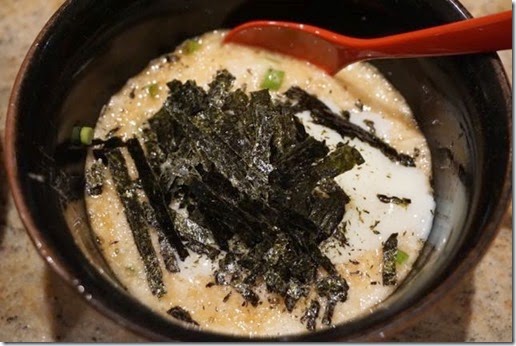
I grated the nagaimo, seasoned with soy sauce with wasabi and chopped scallion. Since I had onsen eggs 温泉卵 which I had made previously sitting in the refrigerator, I dropped that in the middle and garnished it with thin strips of nori seaweed.
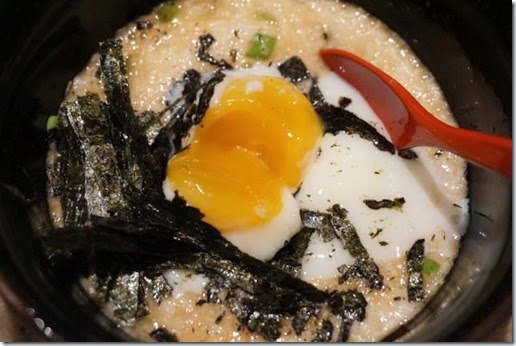
When you dig in you see the nice creamy egg yolk. The egg can be poured over rice and enjoyed as is the traditional way, we just ate as a accompaniment for sake. Since the potato has lots of starch, this is surprisingly filling and remarkably went well with sake.

I grated the nagaimo, seasoned with soy sauce with wasabi and chopped scallion. Since I had onsen eggs 温泉卵 which I had made previously sitting in the refrigerator, I dropped that in the middle and garnished it with thin strips of nori seaweed.

When you dig in you see the nice creamy egg yolk. The egg can be poured over rice and enjoyed as is the traditional way, we just ate as a accompaniment for sake. Since the potato has lots of starch, this is surprisingly filling and remarkably went well with sake.
Monday, April 27, 2015
Hanami 2nd day with cod roe and nagaimo gelée 花見二日目、長芋とたらこのジェル寄せ
This was Sunday and the 2nd day of hanami 2015. The weather was beautiful and we maximized our time outside by spending most of the day on the deck under a canopy of cherry blossoms. We only went inside to line up food items for the hanami. I made cod roe and nagaimo gelée 長芋とたらこのジェル寄せwhich apparently I have not made for some time. I also served daikon namasu 大根なます with salmon roe, cucumber cup with tobiko roe and store bought Chinese style octopus salad.
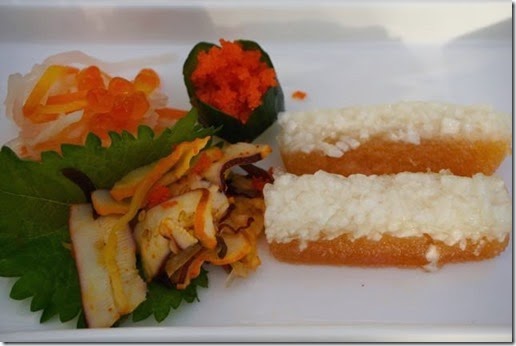
The octopus salad was often served as otoshi at Takogrill but this was the first time we (my wife) found it at our regular Japanese grocery store. Besides slices of boiled octopus legs, it has thin strips of seasoned bamboo shoots or menma メンマ with "Chinese-style" seasoning.
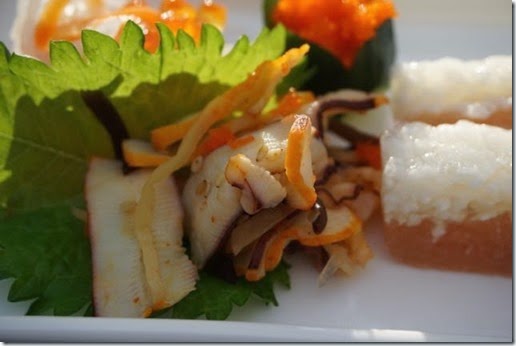
Of course, the main item was my tarako and nagaimo gelée. I posted this some years ago. This time instead of Tabasco, I used Sriracha.
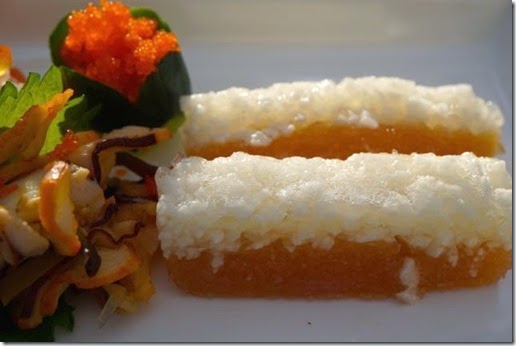
All items on this plate were just perfect for sake, we admired the cherry blossoms and tasted a little of these items and sipped sake. Is there any better way to spend a perfect spring day?

The octopus salad was often served as otoshi at Takogrill but this was the first time we (my wife) found it at our regular Japanese grocery store. Besides slices of boiled octopus legs, it has thin strips of seasoned bamboo shoots or menma メンマ with "Chinese-style" seasoning.

Of course, the main item was my tarako and nagaimo gelée. I posted this some years ago. This time instead of Tabasco, I used Sriracha.

All items on this plate were just perfect for sake, we admired the cherry blossoms and tasted a little of these items and sipped sake. Is there any better way to spend a perfect spring day?
Monday, April 6, 2015
Nagaimo pork roll 長芋の豚肉巻き
Vegetables wrapped in thin slices of meat either pork or beef are a common and favorite theme in Japanese cooking. The most popular version of this theme in the U.S. is probably “Negimaki” 葱巻き which is scallion wrapped in thin slices of beef and then braised in a sweet soy sauce-based sauce. Since I had leftover nagaimo 長芋 and perilla leaves 大葉, I made this dish. Although using thinly sliced pork belly or "sanmai-niku" 三枚肉 would have been the best, I used some pork loin which I happened to have, thinly sliced and then pounded very thin.
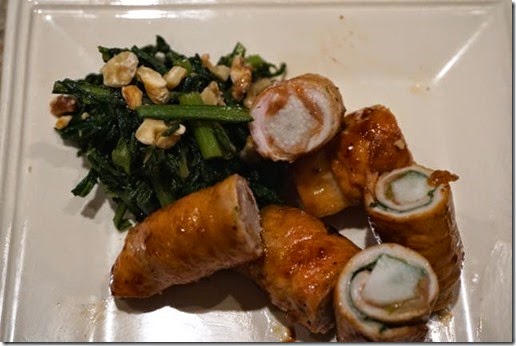
To make it more interesting I also added "bainuki 梅肉" sauce which is umeboshi 梅干し meat (sans stone), finely chopped and then made into a paste using a Japanese mortar or "suribachi" すり鉢 with a small amount of mirin.
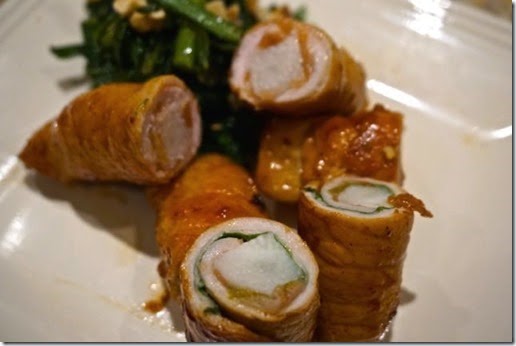
I made 6 sticks of the meat covered nagaimo and served them as an appetizer for two as shown above. I did this by first cutting batons of nagaimo after peeling the skin (approximately half inch thick and 2 inches long) and soaked them in water with a splash of rice vinegar. Meanwhile I cut thin slices of pork loin and pounded them thin using a meat pounder. I then coated the pork with flour using a fine mesh strainer to distribute the flour in a thin coat over the surface of the pork. I then placed a leaf of perilla on the pork, and a baton of nagaimo (after patting it dry using a paper towel) on the perilla, followed by a small amount of the bainiku and then rolled them together (#1 below).
In a non-stick frying pan on medium flame, I added a small amount of vegetable oil and cooked the meat roll first with the seams down turning to brown all sides(#2). I deglazed the brown bits (fond) from the bottom of the pan with sake (1 tbs) and mirin (1 tbs). When browned bits were incorporated, I added soy sauce (about 1-2 tsp) (#3) and shook the pan to roll the meat rolls until the sauce thickened and coated the surface of the meat (#4).
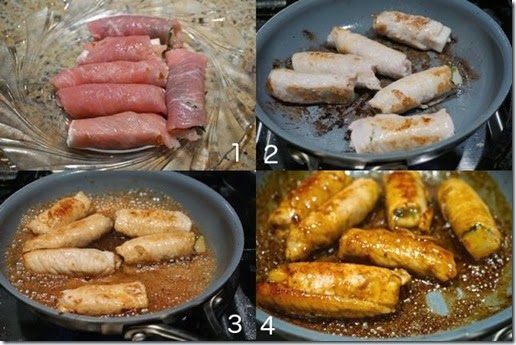
I cut each roll in half and served it with blanched edible chrysanthemum or "shungiku" 春菊 dressed with soy sauce, sugar and Japanese hot mustard mixture and garnished with toasted walnut bits.
The nagainmo was almost raw and still a bit slimy but had a nice crunch. The sliminess did not brother my wife (a good sign). Since the pork was not pork belly, I thought it was a bit dry but it had a nice flavor from the sauce and browning. The perilla and bainiku sauce added to the flavors. So, this was a rather successful starter dish for sake.

To make it more interesting I also added "bainuki 梅肉" sauce which is umeboshi 梅干し meat (sans stone), finely chopped and then made into a paste using a Japanese mortar or "suribachi" すり鉢 with a small amount of mirin.

I made 6 sticks of the meat covered nagaimo and served them as an appetizer for two as shown above. I did this by first cutting batons of nagaimo after peeling the skin (approximately half inch thick and 2 inches long) and soaked them in water with a splash of rice vinegar. Meanwhile I cut thin slices of pork loin and pounded them thin using a meat pounder. I then coated the pork with flour using a fine mesh strainer to distribute the flour in a thin coat over the surface of the pork. I then placed a leaf of perilla on the pork, and a baton of nagaimo (after patting it dry using a paper towel) on the perilla, followed by a small amount of the bainiku and then rolled them together (#1 below).
In a non-stick frying pan on medium flame, I added a small amount of vegetable oil and cooked the meat roll first with the seams down turning to brown all sides(#2). I deglazed the brown bits (fond) from the bottom of the pan with sake (1 tbs) and mirin (1 tbs). When browned bits were incorporated, I added soy sauce (about 1-2 tsp) (#3) and shook the pan to roll the meat rolls until the sauce thickened and coated the surface of the meat (#4).

I cut each roll in half and served it with blanched edible chrysanthemum or "shungiku" 春菊 dressed with soy sauce, sugar and Japanese hot mustard mixture and garnished with toasted walnut bits.
The nagainmo was almost raw and still a bit slimy but had a nice crunch. The sliminess did not brother my wife (a good sign). Since the pork was not pork belly, I thought it was a bit dry but it had a nice flavor from the sauce and browning. The perilla and bainiku sauce added to the flavors. So, this was a rather successful starter dish for sake.
Friday, November 21, 2014
Chinese-style marinated Lotus root and Nagaimo 長芋と蓮根の中華風マリネ
I had a portion of nagaimo in the refrigerator. I had to make something out of it before it went bad. I found this recipe on line and it looked interesting. It is nagaimo and lotus root first deep dried and then soaked in a Chinese style marinade.
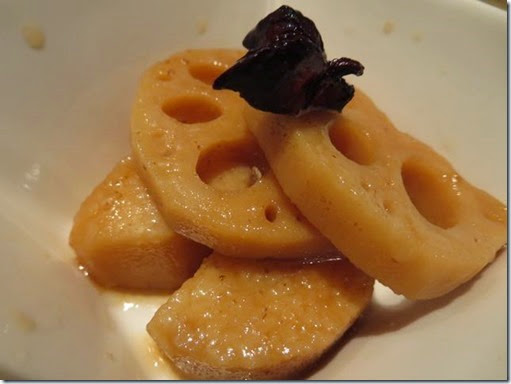
I followed the recipe fairly closely.
Ingredients:
Nagaimo: I had a nagaimo about 3 inches long. I removed the skin and cut it into 1/4 inch think half moon shaped slices. I immediately soaked the slices in cold water with rice vinegar added (just a splash).
Lotus root: I used a segment about 3 inches long of packaged, prepared lotus root. I sliced it into half moon shapes about the same thickness as the nagaimo.
Vegetable oil for deep frying.
For marinade: water (100cc), honey (1 tbs) and soy sauce (1 tbs), salt a small pinch, and star anis (one).
I removed the excess moisture from both the nagaimo and lotus root slices using a paper towel and deep fried it as is for 3-4 minutes at 320 F.
Meanwhile I heated up the marinade until all the ingredients amalgamated. I drained the oil from the deep fried lotus root and nagaimo and placed them in the hot marinade. I let it cool to room temperature and placed it in a sealable container and refrigerated it overnight.
I served the dish cold. The marinade is rather strongly flavored of star anise and a bit sweet to my taste ( I used buckwheat honey which may have a much stronger flavor than regular honey). I may reduce the honey and increase the soy sauce next time. The texture of the nagaimo was nice and soft with no characteristic sliminess. The lotus root was still firm and crunchy. A good small dish with sake. I think, though, I may like this dish with Japanese flavorings (soy sauce, mirin, rice vinegar) better.

I followed the recipe fairly closely.
Ingredients:
Nagaimo: I had a nagaimo about 3 inches long. I removed the skin and cut it into 1/4 inch think half moon shaped slices. I immediately soaked the slices in cold water with rice vinegar added (just a splash).
Lotus root: I used a segment about 3 inches long of packaged, prepared lotus root. I sliced it into half moon shapes about the same thickness as the nagaimo.
Vegetable oil for deep frying.
For marinade: water (100cc), honey (1 tbs) and soy sauce (1 tbs), salt a small pinch, and star anis (one).
I removed the excess moisture from both the nagaimo and lotus root slices using a paper towel and deep fried it as is for 3-4 minutes at 320 F.
Meanwhile I heated up the marinade until all the ingredients amalgamated. I drained the oil from the deep fried lotus root and nagaimo and placed them in the hot marinade. I let it cool to room temperature and placed it in a sealable container and refrigerated it overnight.
I served the dish cold. The marinade is rather strongly flavored of star anise and a bit sweet to my taste ( I used buckwheat honey which may have a much stronger flavor than regular honey). I may reduce the honey and increase the soy sauce next time. The texture of the nagaimo was nice and soft with no characteristic sliminess. The lotus root was still firm and crunchy. A good small dish with sake. I think, though, I may like this dish with Japanese flavorings (soy sauce, mirin, rice vinegar) better.
Tuesday, July 29, 2014
Sparkling Sake スパークリング清酒
We have tried a few sparkling sakes in the past. We were not particularly fond of these sparkling sakes. Since we have not tried more recent versions of sparkling sake and saw one in the nearby liquor store, I decided to try it.
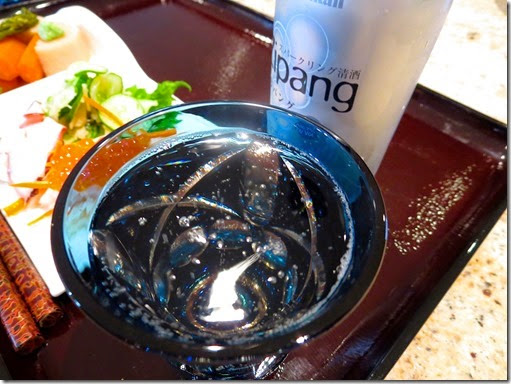
This is called "Zipang" from Gekkeikan 月桂冠 (imported from Japan). My understanding is that, "Zipang" is one of the oldest names referring to Japan which was supposedly mentioned by Marco Polo as a country of pearls and gold. This particular sake came in a 250ml bottle. The alcohol content is low at 7%. According to the website of "Gekkeikan sake" 月桂冠酒 (In Japanese), the carbonation is from the secondary fermentation in a tank in low temperature (with sugar, I assume like the beer/ale I used to make) rather than injected carbon dioxide. The carbonation pressure is between beer and champagne using the innovative technique of filtering out spent yeast without losing the carbonation. It appears to be especially aimed at the American market and started exporting to US in 2005.
When poured, it is clear with a rather gentle effervescence. No particular aroma can be detected. The taste is very subtle, clean with very slight sweetness but not much else. I am sure, as their web site states, this will be very acceptable to the Western palate and, if you were not told this is sparkling sake, you certainly could not tell this is sake. It almost tastes like Sprite without the citrus flavor and less sweetness. It is food neutral as are other sparkling wines and is refreshing especially in warm weather but we were not sure this is anything we would like to try again. It should have some more taste/favor to distinguish this as a type of sake. I have to admit, though, this is much better than sparkling turbid sake we tried many years ago in a Japanese restaurant in Napa.
We had this sparkling sake with cold simmered vegetables (this time instead of daikon 大根, I used nagaimo 長芋) in addition to carrot and blanched broccolini (left). I also served Japanese cucumber sunomono with semi-dried scallop 胡瓜と貝柱の酢の物, daikon namasu 大根ナマス garnished with salmon roe and few slices of octopus leg. This time, I used sweet vinegar I made few days ago as a dressing.
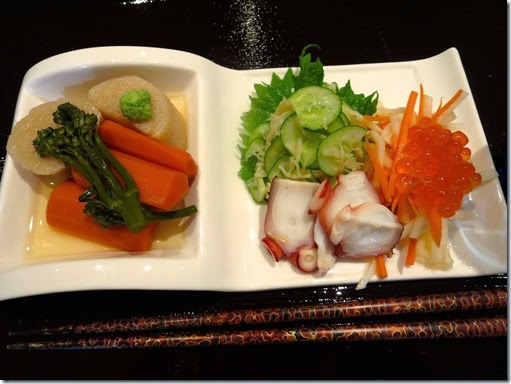
Like sake, this sparkling wine did not complete with the vinegar in these dishes. However, we would rather have regular sparkling wine and/or champagne.

This is called "Zipang" from Gekkeikan 月桂冠 (imported from Japan). My understanding is that, "Zipang" is one of the oldest names referring to Japan which was supposedly mentioned by Marco Polo as a country of pearls and gold. This particular sake came in a 250ml bottle. The alcohol content is low at 7%. According to the website of "Gekkeikan sake" 月桂冠酒 (In Japanese), the carbonation is from the secondary fermentation in a tank in low temperature (with sugar, I assume like the beer/ale I used to make) rather than injected carbon dioxide. The carbonation pressure is between beer and champagne using the innovative technique of filtering out spent yeast without losing the carbonation. It appears to be especially aimed at the American market and started exporting to US in 2005.
When poured, it is clear with a rather gentle effervescence. No particular aroma can be detected. The taste is very subtle, clean with very slight sweetness but not much else. I am sure, as their web site states, this will be very acceptable to the Western palate and, if you were not told this is sparkling sake, you certainly could not tell this is sake. It almost tastes like Sprite without the citrus flavor and less sweetness. It is food neutral as are other sparkling wines and is refreshing especially in warm weather but we were not sure this is anything we would like to try again. It should have some more taste/favor to distinguish this as a type of sake. I have to admit, though, this is much better than sparkling turbid sake we tried many years ago in a Japanese restaurant in Napa.
We had this sparkling sake with cold simmered vegetables (this time instead of daikon 大根, I used nagaimo 長芋) in addition to carrot and blanched broccolini (left). I also served Japanese cucumber sunomono with semi-dried scallop 胡瓜と貝柱の酢の物, daikon namasu 大根ナマス garnished with salmon roe and few slices of octopus leg. This time, I used sweet vinegar I made few days ago as a dressing.

Like sake, this sparkling wine did not complete with the vinegar in these dishes. However, we would rather have regular sparkling wine and/or champagne.
Subscribe to:
Posts (Atom)



























